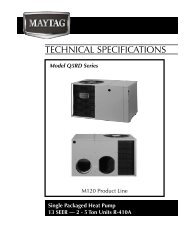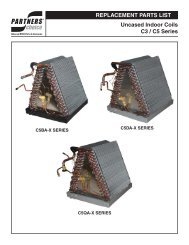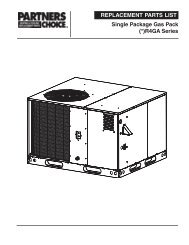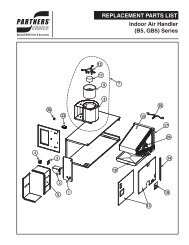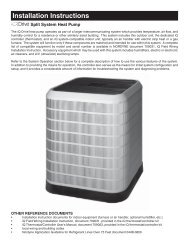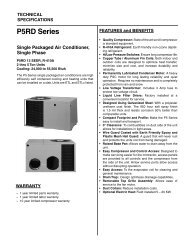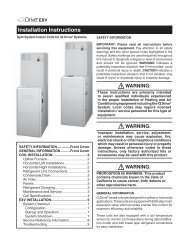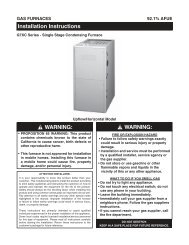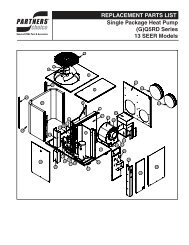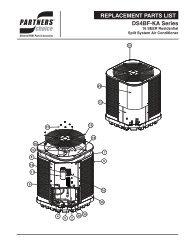warning - Nordyne
warning - Nordyne
warning - Nordyne
You also want an ePaper? Increase the reach of your titles
YUMPU automatically turns print PDFs into web optimized ePapers that Google loves.
allowable vent length. Returning to our example,we consult Table 5 and determine that for an80,000 Btu/h furnace the maximum vent lengthfor 2” diameter piping is 60 feet or for 3” diameterpiping is 150 feet. Note that the maximum ventlength given in Table 5 includes one long radiuselbow. Therefore, for our example, we have threeadditional long radius elbows for which we mustadd to our piping. Each long radius elbow isequivalent to 2.5 feet, so we must add 7.5 feetto our vent length. Therefore, the equivalent ventlength for our installation is 47.5 feet. We comparethis with the maximum vent length for 2” and 3”diameter piping. For both cases, our equivalentvent length is less than the maximum allowablevent length, so for our “one-pipe” installation wecan use either 2” or 3” diameter piping.Condensing furnace combustion products havevery little buoyancy, so Table 5 is to be usedwithout consideration of any vertical rise in thepiping.NOTE: Always use the same or larger sizepiping for combustion air as is used for theexhaust vent.Vent Pipe InstallationPipe Routing and SupportRoute piping as directly as possible betweenthe furnace and the outdoors and rememberthat routing affects pipe size requirements perthe preceding section. If a two pipe system isused, locate the combustion air intake and thevent exhaust in the same atmospheric pressurezone - i.e. both must exit the building though thesame portion of exterior wall or roof (See Figure22). Vent piping must be sloped upwards notless than 1/4” per foot in the direction from thefurnace to the terminal. This is to ensure thatany condensate flows back to the furnace (whereit can be disposed of through the condensatedisposal system).The quality of outdoor air must also be considered.Be sure that the combustion air intake isnot located near a source of solvent fumes orother chemicals which can cause corrosion ofthe furnace combustion system.CAUTION:Combustion air must not be drawnfrom a corrosive atmosphere.Piping must be mechanically supported so thatits weight does not bear on the furnace. Supportsmust be at intervals no greater than fi vefeet, and at smaller intervals if necessary toensure that there are no sagging sections totrap water. (See Figure 16.) It is recommendedto install couplings along the vent pipe, on eitherside of the exterior wall. These couplings maybe required by local code.Figure 18 illustrates vent and combustion air pipesizes exiting the furnace. Transition to the correctpipe size must be done close to the furnace sothat the full length of pipe is of proper size.Straight neoprene couplings are supplied withthe downfl ow furnaces only. These couplingsare to be installed in the combustion air inlet (ifpresent) and exhaust vent piping at the furnaceas shown in Figures 16. For an upfl ow furnaceinstallation, if breakable connections are requiredin the combustion air inlet (if present) and exhaustvent piping, then straight neoprene couplings for2” or 3” piping with hose clamps can be used.These couplings can be ordered through yourlocal furnace distributor.To install a coupling, slide the rubber couplingover the end of the pipe that is attached to thefurnace and secure it with one of the hose clamps.Then slide the other end of the rubber couplingonto the other pipe from the vent and secure thecoupling with the second hose clamp. Ensure thatthe connection is tight and leak free.NORDYNE condensing furnaces have been certified for installation with zero clearance betweenvent piping and combustible surfaces. However,it is good practice to allow space for conveniencein installation and service.Location of Outdoor TerminationsHorizontal VentingVent and combustion air intake terminationsmust be as shown in Figure 19 and 20. Venttermination clearances shall be consistent withthe National Fuel Gas Code, ANSI 2223.1/NFPA54 and/or the CSA B149.1, Natural Gas andPropane Installation Code.All minimum clearances specifi ed must bemaintained to protect building materials fromdegradation by fl ue gases.20



